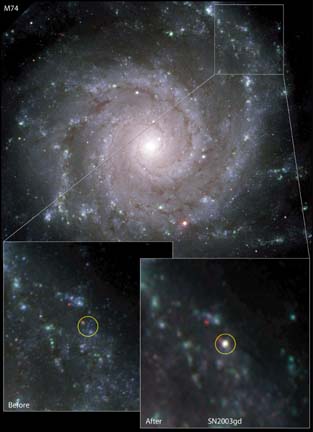
[ SCIENCE ]
COURTESY OF GEMINI OBSERVATORY
These photos show a supernova, or giant star, before it exploded, on the left, and afterward.
Mauna Kea captures
death of a supernovaAstronomers also saw the event
using the Hubble Telescope
HILO >> Astronomers using the Gemini telescope on Mauna Kea and the Hubble Space Telescope have obtained rare "before" and "after" images of a giant star blowing apart, they announced this week.
The death of the red "supergiant" in an explosive supernova was seen last year in a galaxy called M-74, a Gemini statement said.
It was only the third time in the history of astronomy that detailed images of an area of the sky had been made beforehand which could be used for comparison with the supernova images.
More than 2,000 supernovas have been seen outside the Milky Way galaxy, but the only two others with good "before" images were seen in 1987 and 1993, according to the European Space Agency.
This latest one, called SN2003gd, proved something astronomers long suspected, that a "normal" red giant would end in an explosion.
Before blowing up, SN2003gd had a diameter bigger than the orbit of Mars, Gemini said.
A star as small as the Sun doesn't have enough mass to cause the collapse and rebounding explosion of a supernova, Gemini said.
SN2003gd was first seen by amateur astronomer Robert Evans of New South Wales, Australia, using a back-yard telescope in June.
The news reached astronomer Stephen Smartt at the University of Cambridge, England, who has led a team preparing for such an event by making images of hundreds of galaxies.
"We've been searching for this sort of normal progenitor star on its deathbed for some time," Smartt said.
Amateurs can do their own watch without a telescope, Gemini said. The star Betelgeuse in the shoulder of the constellation Orion is a red giant which might explode thousands of years from now or as soon as next week, the observatory said.
The star that blew up in 1987 was a blue giant, Gemini said.
The 1993 supernova was thought to be a red giant with a small companion. The University of Hawaii Institute for Astronomy announced recently that it found the surviving companion last year using the Hubble telescope and one of the Keck telescopes on Mauna Kea.
